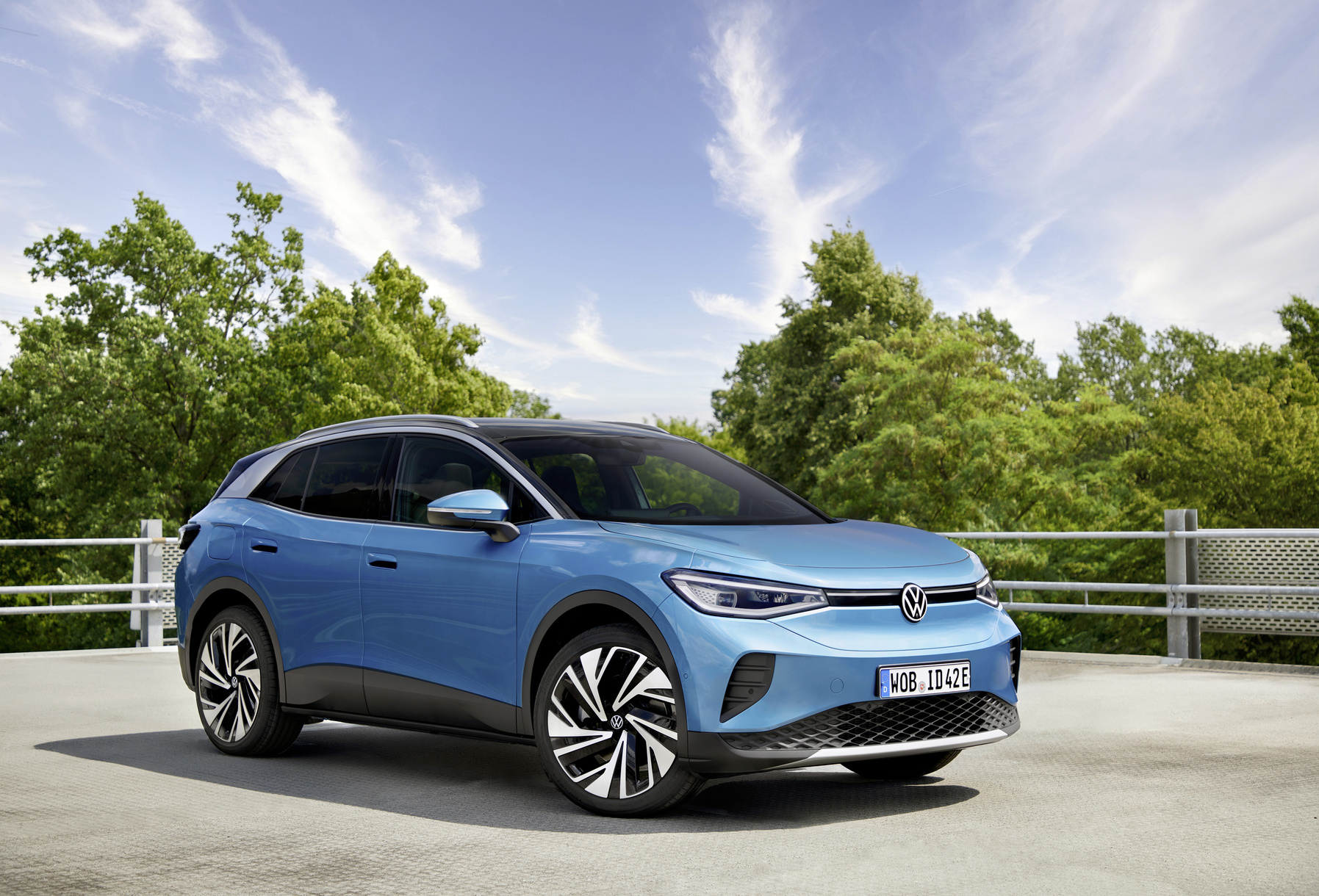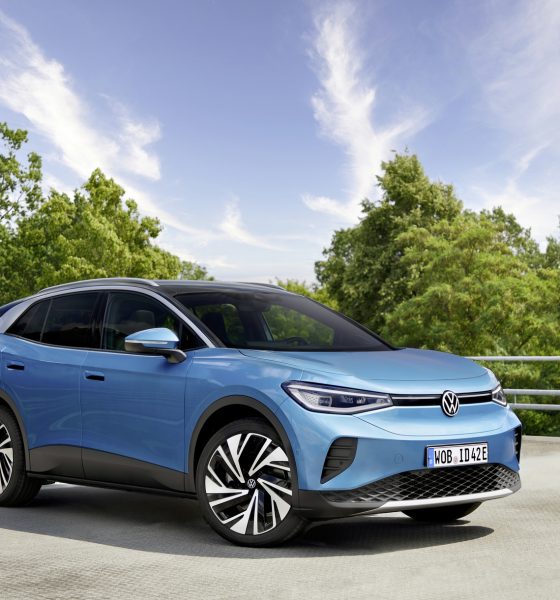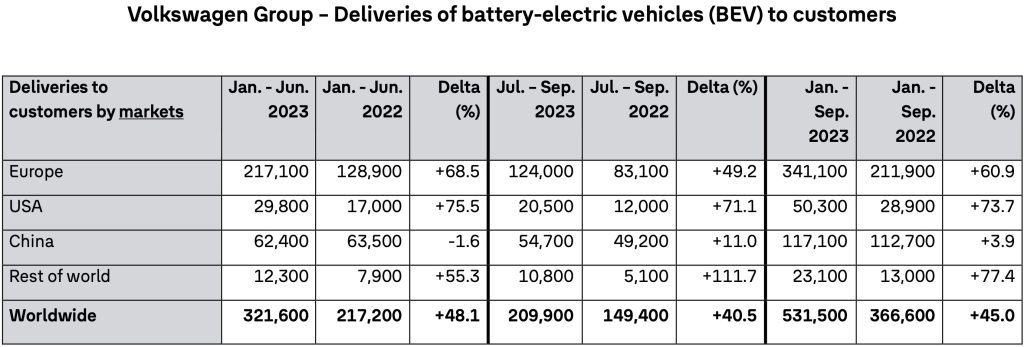

News
Volkswagen BEV deliveries increase by 45% globally
Volkswagen Group has been working hard to increase its share of the global battery electric vehicle (BEV) market, and it seems to be paying off. The German automaker increased its BEV deliveries by 45% globally as of September 2023.
Volkswagen Group reported delivering 531,500 battery electric vehicles from January to September 2023, up 45% compared to the same period in 2022 when VW delivered 366,600 BEVs. As of September, the German car maker’s BEV share of total deliveries is 7.9%. Last year, Volkswagen’s BEVs made up 6.1% of deliveries between January and September 2022.
“We showed a good overall performance in our all-electric deliveries with a global increase of 45 percent in the first nine months. Despite the current general reluctance in the European market to buy battery-powered vehicles, we gained market share and remained market leader in this segment. However, our order intake is below our ambitious targets due to the lower-than-expected overall market trend.
“We showed a good overall performance in our all-electric deliveries with a global increase of 45 percent in the first nine months. Despite the current general reluctance in the European market to buy battery-powered vehicles, we gained market share and remained market leader in this segment. However, our order intake is below our ambitious targets due to the lower-than-expected overall market trend,” said Hildegard Wortmann, a member of VW Group’s Extended Executive Committee for Sales.

The most popular BEV model in the Volkswagen Group is the VW ID.4 and VW ID.5, with 162,100 units sold within the first nine months of 2023. VW recently upgraded the ID.4 and ID.5.
In second place is the Volkswagen ID.3, which sold 90,500 units from January to September. The company sold 90,500 Audi Q4 3-tron units, making it the third best-selling BEV in the company.
The Audi Q8 e-tron was also one of Volkswagen Group’s most successful BEV models this year, with 21,800 units sold. It was beaten by the ŠKODA Enyaq iV and CUPRA Born, with 54,400 and 32,300 units sold, respectively.
In Q3 2022, VW’s BEV share rose 9.0%, up compared to 6.8% in the second quarter of 2022. Between July and September 2023, Volkswagen delivered 209,900 all-electric vehicles worldwide. In Q3 2022, the legacy automaker reported delivering 149,400 electric vehicles.
Europe accounted for up to 64% of Volkswagen’s electric vehicle deliveries in the third quarter. China made up 22% of VW’s BEV deliveries, and the United States only accounted for 10%. Other markets accounted for 4% of Volkswagen’s BEV deliveries.
Volkswagen aims to gain 10% market share in the United States by 2030. In March 2023, it claimed a 4% market shared in the USA, including BEV and ICE vehicle sales. VW believes the ID.Buzz and ID.7 will drive its expansion in the United States.
The Teslarati team would appreciate hearing from you. If you have any tips, contact me at maria@teslarati.com or via X @Writer_01001101.

News
Tesla gets a win in Sweden as union withdraws potentially “illegal” blockade
As per recent reports, the Vision union’s planned anti-Tesla action might have been illegal.

Swedish union Vision has withdrawn its sympathy blockade against Tesla’s planned service center and showroom in Kalmar. As per recent reports, the Vision union’s planned anti-Tesla action might have been illegal.
Vision’s decision to pull the blockade
Vision announced the blockade in early December, stating that it was targeting the administrative handling of Tesla’s facility permits in Kalmar municipality. The sympathy measure was expected to start Monday, but was formally withdrawn via documents sent to the Mediation Institute and Kalmar Municipality last week.
As noted in a Daggers Arbete report, plans for the strike were ultimately pulled after employer group SKR highlighted potential illegality under the Public Employment Act. Vision stressed its continued backing for the Swedish labor model, though Deputy negotiation manager Oskar Pettersson explained that the Vision union and IF Metall made the decision to cancel the planned strike together.
“We will not continue to challenge the regulations,” Petterson said. “The objection was of a technical nature. We made the assessment together with IF Metall that we were not in a position to challenge the legal assessment of whether we could take this particular action against Tesla. Therefore, we chose to revoke the notice itself.”
The SKR’s warning
Petterson also stated that SKR’s technical objection to the Vision union’s planned anti-Tesla strike framed the protest as an unauthorized act. “It was a legal assessment of the situation. Both for us and for IF Metall, it is important to be clear that we stand for the Swedish model. But we should not continue to challenge the regulations and risk getting judgments that lead nowhere in the application of the regulations,” he said.
Vision ultimately canceled its planned blockade against Tesla on December 9. With Vision’s withdrawal, few obstacles remain for Tesla’s long-planned Kalmar site. A foreign electrical firm completed work this fall, and Tesla’s Careers page currently lists a full-time service manager position based there, signaling an imminent opening.
News
Tesla Semi program Director teases major improvements

Tesla Semi Program Director Dan Priestly teased the major improvements to the all-electric Class 8 truck on Thursday night, following the company’s decision to overhaul the design earlier this year.
Priestley said he drove the Semi on Thursday, and the improvements appear to be welcomed by one of the minds behind the project. “Our customers are going to love it,” he concluded.
Just drove the redesigned Semi. Our customers are going to love it. https://t.co/KZ88sf1CDL
— Dan Priestley (@danWpriestley) December 19, 2025
The small detail does not seem like much, but it is coming from someone who has been involved in the development of the truck from A to Z. Priestley has been involved in the Semi program since November 2015 and has slowly worked his way through the ranks, and currently stands as the Director of the program.
Tesla Semi undergoes major redesign as dedicated factory preps for deliveries
Tesla made some major changes to the Semi design as it announced at the 2025 Annual Shareholder Meeting that it changed the look and design to welcome improvements in efficiency.
Initially, Tesla adopted the blade-like light bar for the Semi, similar to the one that is present on the Model Y Premium and the Cybertruck.
Additionally, there are some slight aesthetic changes to help with efficiency, including a redesigned bumper with improved aero channels, a smaller wraparound windshield, and a smoother roofline for better aero performance.
All of these changes came as the company’s Semi Factory, which is located on Gigafactory Nevada’s property, was finishing up construction in preparation for initial production phases, as Tesla is planning to ramp up manufacturing next year. CEO Elon Musk has said the Semi has attracted “ridiculous demand.”
The Semi has already gathered many large companies that have signed up to buy units, including Frito-Lay and PepsiCo., which have been helping Tesla test the vehicle in a pilot program to test range, efficiency, and other important metrics that will be a major selling point.
Tesla will be the Semi’s first user, though, and the truck will help solve some of the company’s logistics needs in the coming years.
News
Tesla dominates in the UK with Model Y and Model 3 leading the way

Tesla is dominating in the United Kingdom so far through 2025, and with about two weeks left in the year, the Model Y and Model 3 are leading the way.
The Model Y and Model 3 are the two best-selling electric vehicles in the United Kingdom, which is comprised of England, Scotland, Wales, and Northern Ireland, and it’s not particularly close.
According to data gathered by EU-EVs, the Model Y is sitting at 18,890 units for the year, while the Model 3 is slightly behind with 16,361 sales for the year so far.
The next best-selling EV is the Audi Q4 e-tron at 10,287 units, lagging significantly behind but ahead of other models like the BMW i4 and the Audi Q6 e-tron.
GOOD NEWS 🇬🇧 Tesla is absolutely crushing the UK electric vehicle market in 2025 💥
The numbers are in, and the dominance is clear. With an impressive amount of 42,270 vehicles delivered year-to-date, the brand now commands a solid 9.6% market share of the total auto market 🆒… pic.twitter.com/dkiGX9kzd0
— Ming (@tslaming) December 18, 2025
The Model Y has tasted significant success in the global market, but it has dominated in large markets like Europe and the United States.
For years, it’s been a car that has fit the bill of exactly what consumers need: a perfect combination of luxury, space, and sustainability.
Both vehicles are going to see decreases in sales compared to 2024; the Model Y was the best-selling car last year, but it sold 32,610 units in the UK. Meanwhile, the Model 3 had reached 17,272 units, which will keep it right on par with last year.
Tesla sold 50,090 units in the market last year, and it’s about 8,000 units shy of last year’s pace. It also had a stronger market share last year with 13.2 percent of the sales in the market. With two weeks left in 2025, Tesla has a 9.6 percent market share, leading Volkswagen with 8 percent.
The company likely felt some impact from CEO Elon Musk’s involvement with the Trump administration and, more specifically, his role with DOGE. However, it is worth mentioning that some months saw stronger consumer demand than others. For example, sales were up over 20 percent in February. A 14 percent increase followed this in June.








